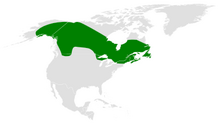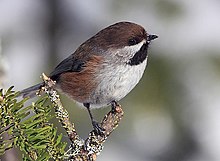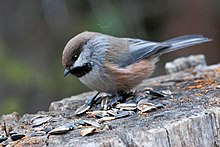Hudson tit
| Hudson tit | ||||||||||||
|---|---|---|---|---|---|---|---|---|---|---|---|---|

Hudson's tit ( Poecile hudsonica ) |
||||||||||||
| Systematics | ||||||||||||
|
||||||||||||
| Scientific name | ||||||||||||
| Poecile hudsonicus | ||||||||||||
| ( Forster , 1772) |
The Hudson's tit ( Poecile hudsonicus , Syn . : Poecile hudsonica ) is a songbird from the tit family that is widespread in North America . It is one of the largest tits in North America and is a resident bird . It survives the harsh winter conditions in its range by stocking up on winter supplies. There are several subspecies for this titmouse species.
The population of the Hudson's tit was classified in the IUCN Red List of Threatened Species in 2016 as “ Least Concern (LC) ” = “not endangered”.
features
The Hudson's tit reaches a body length of 14 centimeters, making it one of the largest tit species in North America.
The Hudson's tit has a gray-brown upper surface with a brown hood, gray wings and a gray tail. The cheeks are noticeably gray. The underside is mostly white with brown flanks and a black throat. The sides of the body and the flanks are either matt maroon, red-brown or yellow-brown, depending on the subspecies.
The Hudson's tit has a short dark beak, short wings, and a long, notched tail.
Possible confusion
The black-headed tit , the red-backed tit and the Lapland tit are also found in the distribution area. Due to the brown skull and the color of the wings, the Hudson's tit can hardly be confused with the black-headed tit. The distinguishing features of the red-backed tit and the Lapland tit are the darker face and the more matt wing color.
Occurrence
The bird inhabits coniferous forests in Alaska , Canada and the northern United States . Although it is actually a resident bird , it can migrate a little further south in the winter months. According to current knowledge, the trigger for these irregular migrations is a lack of suitable food. The Hudson's tit can then also be observed sporadically in US states such as West Virginia , Virginia , Pennsylvania and New Jersey .
behavior
The Hudson's tit looks for insects and seeds on conifers and also builds supplies. In winter, the bird goes foraging in small groups, also with other species.
Outside the breeding season , the Hudson's tit is very trusting towards humans. During the breeding season, however, it barely lets its voice be heard and is difficult to observe.
Reproduction
The bird breeds in a tree hole, which it either builds itself or takes over from a woodpecker . The breeding pair stays together all year round, sometimes all of life.
Trivia
The genus Poecile is actually feminine, so the specific epithet should actually be hudsonica . However, the first descriptor of the genus, Johann Jakob Kaup , did not recognize this and under the rules of the ICZN the genus must therefore be treated as male, which leads to the specific epithet hudsonicus .
literature
- Jonathan Alderfer (Ed.): Complete Birds of Northamerica. National Geographic, Washington DC 2006, ISBN 0-7922-4175-4 .
- Josep del Hoyo et al .: Handbook of the Birds of the World. (HBW), Volume 12: Picathartes to Tits and Chickadees. Lynx Edicions, Barcelona 2007, ISBN 84-96553-42-6 .
- Millicent S. Ficken , Margaret A. McLaren, Jack P. Hailman: Boreal Chickadee (Poecile hudsonicus) , version 2.0. In: AF Poole & Frank B. Gill (Eds.): Birds of North America , Cornell Lab of Ornithology, Ithaca, NY, USA. 1996.
Web links
- Poecile hudsonicus inthe IUCN 2013 Red List of Threatened Species . Listed by: BirdLife International, 2012. Retrieved September 4, 2016.
- Voice of the Hudson tit on Xeno-Canto
- Hudson tit on Avibase
- The Hudson tit in Cornell Lab of Ornithology
Single receipts
- ↑ a b c d e Alderfer (Ed.): Complete Birds of Northamerica. P. 445.
- ↑ poecile hudsonicus in the endangered Red List species the IUCN 2016 Posted by: BirdLife International, 2016. Accessed January 29, 2018th
- ↑ J. del Hoyo, A. Elliot, D. Christie (Eds.): Handbook of the Birds of the World , Volume 12: Picathartes to Tits and Chickadees. Lynx Edicions , Barcelona 2007, ISBN 978-84-96553-42-2 .


